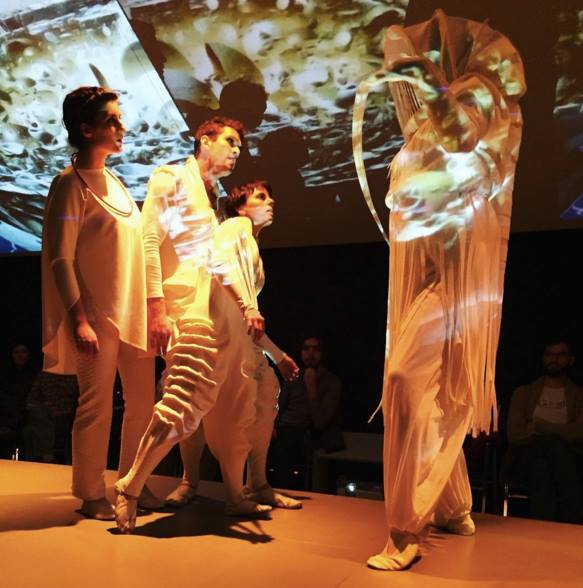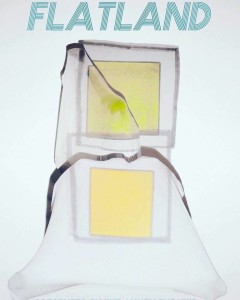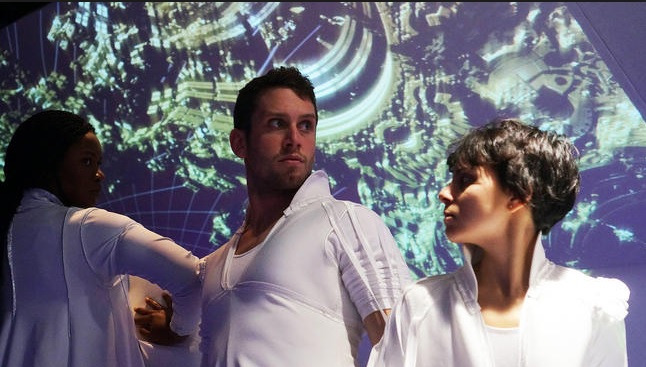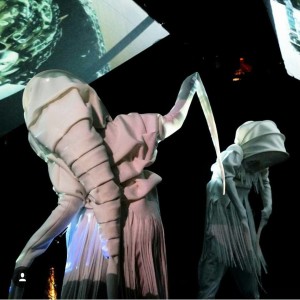Stop trying to recognize. Start learning to dream. For irregularity is more beautiful than symmetry could ever be. Lost in the dimensional reality of the above statement? Hold onto your depth perception, kids, the ride over at Annex Theater is about to warp into hyperspace beyond the capacity of mere mortal minds. Transcending the borders of the dimensional continuum from dimensions D to 10thD, The Annex Theater of Baltimore is going to blow your mind, literally, figuratively, spatially, dimensionally, and any other –ally that you can possibly think of with their fandangoing-trip-the-life-fantastic production of Flatland. Adapted from the novella of Edwin A. Abbott by Evan Moritz, who Co-Directs the production with Isa Leal, this stimulatory-overload piece of theatre is one for the books, the graphs, the charts, and anything else in which you can take note.

Not being one for summary or plot outlines (and a show like this is certainly no place to start) I will say this— the following super brief expository explanation of how the dimensional parameters work may assist you in so much as it did me when attempting to absorb this hyper-sensory immersive piece of performance art.
D— Lines
2D— Shapes: flat without dimension (think circle, square, triangle)
3D— Add depth (cube, sphere, pyramid)
4thD— Time (now with linearity!)
5thD— Tape-player style time travel (you can go backward and forward, like a rewind or fast-forward button)
6thD— TARDIS+ time travel (all points of time and space in addition to all potential points of time and space)
7thD/8thD— dimensions that exist but would need another full-length play to explain
9thD— world of dreams (also everything that’s come before it) and apparently no gravity
10thD— A big interpretive dance-based movement showcase with slow-motion, the ultimate dimension
In addition to deconstructing, reconstructing, constructing, and creating a reality in which these dimensions and their denizens can play, Co-Director and Adapter Evan Moritz has set forth an enormous challenge to his production design team, a challenge which these spectacularly talented and wildly chimerically imaginative artists have answered soundly. Laying the ground work, perhaps the initial dimension of the show’s visual and overall aesthetic construction, Set Designer Douglas Johnson creates table-tennis seating over a long narrow runway. This immediately primes the audience for the first and second dimension in which the play initially starts.

Johnson divides the space with long white screens, a scenic construct which at first seems confusing but as Projection Artist Kevin Blackistone gets things underway in tandem with Lighting Designer Mason Ross, Johnson’s intent becomes clear. Words cannot properly describe nor do any sort of proper justice— in any relative dimension— to the stunning visual spectacle that arises in Blackistone and Ross’ union of work as witnessed against Johnson’s unique spatial setup. And much like building blocks, Sound Designer Allison Clendaniel mounts the surreal otherworldly shoulders of the show’s visual approach and stacks the soundscape and Original Music (composed by Clendaniel and Nudie Suits) to the Nth Dimension of bizarre but beautifully serene.
The production design team is indeed reaching for the new and imagining a greater, more beautiful world with all of these elements carefully layered over one another, creating a hyper realistic and simultaneously absurdistly surreal environment that causes the mind to implode upon itself while attempting to drink it all in. There is a profound quote from the play (there are in fact many profound quotes that Moritz plays up throughout the production, this is only one of them) that best befits the notions behind the design work as a conceptual whole and it is this: “What we see as imperfect is wholly more beautiful because it’s imperfect.”

Costume Designer Susan MacCorkle deserves the highest dimension of praise for her obtusely acute and acutely obtuse couture featured in this production. The color scheme is that of pure white (leave the painting of the sides to Ross, Johnson, and Blackistone) and in a sense this brings a balance and an order to the frenetic chaos of movement that happens in a continual loop throughout the show. What’s most impressive about MacCorkle’s work is the versatility of the costumes, enabling characters to shift from triangles and circles (among a great many other identifiable and non-identifiable shapes) with ease and fluidity that fits the overall motion of the performance.
Co-Directors Evan Moritz and Isa Leal inspire a cacophony of movement throughout the performance that is the driving focus of the show. While there is clearly text, which Moritz has painstakingly sifted through to carve out the core of a plot structure, it’s the show’s choreography— it can be called nothing more plainly as to fully articulate its striking beauty— that becomes a focal plot point and character all its own. There is a chaotic beauty that is both jarringly unsettling and accidentally majestic when the bodies of Ren Pepitone and Eric Park collide (whilst in their 4th Dimensional character existences) feeling a bit like gangly giraffes at the icescapes while plotting their prison break plan. This is as glorious as the rigidity witnessed by those that surge about in ‘Flatland’ the 2-dimensional spatial plane, their angular and blunt turns showcasing the strict linearity of their dimension. One could easily write words into infinity about the two hours’ variety of movement that crosses the stage, but it would be easier to take a few simple words that say “go see it for yourself,” in this case.
The nine-person ensemble do an exceptional job of shifting their character personas throughout as every performer, with the exception of a pair, take on multiple shaped-roles. Trustina Fafa Sabah plays “Sphere” and is encountered by the maverick, Chromatistes (Caroline Preziosi.) Sabah speaks with authority, like a true prophet on a mission The most unique element of Sabah’s performance is her ability to move so fluidly in the third dimension. Comparatively, Sabah’s character moves as any normal existing human-being might, but juxtaposed against the other intense physicalities of the other dimensional denizens, Sabah appears to possess a mastery of the body that is completely astonishing to the human condition.

Preziosi, as the fugitive Chromatistes, is possessed of an insatiable curiosity, which is intoned and reflected in both her textual tonality and her physical movement. There is an inherent conviviality to Preziosi’s portrayal of Chromatistes as well. Lacking for nothing in the character’s innovative moments of discovery of other dimensions, Preziosi exposes the audience to Chromatistes’ knowledge as it is unfurled, making this a remarkable encounter even if the stackable logic of expandable dimensions is a preconceived notion upon entering the performance.
Moritz’ adaptation is infused with a surprising amount of linearity in the narrative given the jumble of dimension, time skips, spatial realities, and the juxtaposition of all of that from the page to the stage. Jonathan Jacobs, a long-standing Annex Theater performer, takes on the role of Trignokratore, a narrative guide if you will, that touches base with the audience from time to time in a distracted soliloquial fashion. Fully in touch with the story his character is explaining, this is a comfort to anyone in the audience that might be attempting to follow some sort of structure to the initial storyline.

It becomes a bit trickier to discuss the performances of Carly Bales, Jess Rivera, and Lee Conderacci, who are Circles, High Council Members, Time-Space-Sand-Worm-Creatures, and a number of other things. There is a striking moment, however, where the Time-Space-Sand-Worm-Creature appears and the scene unfurls a bit like a mashup of the Three Fates from Macbeth thrown into a blender with the High Council of Gallifrey meeting the space creatures from Invader Zim. Adding to the insane and yet enthralling performances of the aforementioned trio is Dave Iden, appearing as Fenir in one of the penultimate dimensions as something mostly unsavory. It’s a blur of living shapes, colors, textures, and motions that make for a shocking yet captivating performance.
If the mind can race past the sensory overload and overstimulation of all the visual and audio cues, and the time can be found to sit through it a second time, there is truly a profound takeaway— between the absolute pandimonious beauty in the aesthetic and the overarching social commentary of basic war-torn revolutionary principles as applied to the geometric planes of existence.
Running Time: Approximately 2 hours with one intermission
Flatland plays through February 7, 2016 at Annex Theater— 219 Park Avenue in Baltimore, MD. Tickets may be purchased at the door or in advance online.

